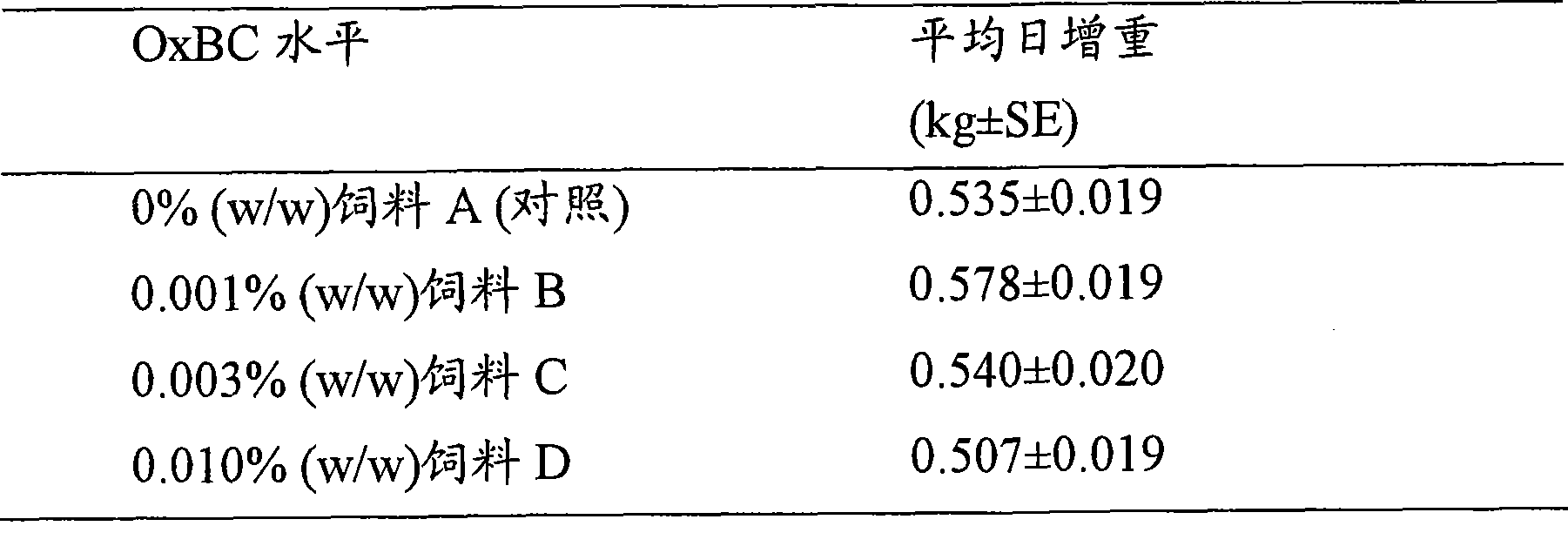Carotenoid-containing dietary supplement
A carotene and carotene technology, which is applied in food science, food preparation, additional food elements, etc., can solve problems such as problems in the use of additives
- Summary
- Abstract
- Description
- Claims
- Application Information
AI Technical Summary
Problems solved by technology
Method used
Image
Examples
Embodiment 1
[0477] Example 1: Effect of oxidatively transformed carotenoids on pig growth and feed conversion
[0478] The effects of oxidatively transformed carotenoids as food additives on growth and feed conversion were analyzed in 2 groups of 48 weaned pigs aged 18-21 days.
[0479] The first 48 pigs were randomized into 16 pens (3 pigs / pen) that were equally divided between two temperature-controlled rooms. All 24 pigs in one room were injected with an attenuated vaccine against porcine respiratory and reproductive syndrome (vaccination room) and the other 24 pigs were injected with a saline solution placebo (control room).
[0480] 2 pens / room were randomly assigned one of 4 feeds consisting of a mixture of oxidatively transformed β-carotene (OxBC) and a commercial pig feed.
[0481] OxBC was prepared as follows. A suspension of β-carotene in ethyl acetate was brought to oxygen saturation by bubbling oxygen through at room temperature while the mixture was stirred. After 8 days, ...
Embodiment 2
[0499] Example 2: Effect of oxidatively transformed carotenoids on growth behavior of broiler chickens
[0500] Upon arrival, a total of 1600 Ross x Ross 308 cockerels were assigned to treatment groups. There are 8 units in the study, each unit comprising 4 pens. The in-unit pens were randomly and evenly assigned to treatment groups (A, B, C, D). There were 50 birds per pen, and each pen within the unit contained birds of similar initial body weight. Using a randomized full unit design, the effects of the following four treatment groups in a randomized full unit design were studied:
[0501] Feed A (control): commercially available feed without OxBC
[0502] Feed B: commercial feed containing 0.0005% (w / w) OxBC
[0503] Feed C: commercial feed containing 0.001% (w / w) OxBC
[0504] Feed D: commercial feed containing 0.003% (w / w) OxBC
[0505] Treatment feeds were introduced on day 0 and continued until the end of the study on day 38. Chickens were given water ad libitum ...
Embodiment 3
[0517] Example 3: Optimizing study of pig dosage
[0518] A total of 240 pigs were assigned to treatment groups when weaned. Eight units were used in this study, each unit comprising 5 pens. One of the feeds (A, B, C, D or E) was randomly and evenly distributed among the pens of each unit. There are 6 pigs in each pen.
[0519] The following 5 feeds A-E used in the pig dosage optimization study contained OxBC at levels of 0, 0, 1, 2 and 5 mg / kg pig feed.
[0520] Feed A (control): commercially available feed without OxBC
[0521] Feed B (control): commercially available feed + drug without OxBC
[0522] Feed C: commercially available feed containing 0.0001% (w / w) OxBC
[0523] Feed D: commercial feed containing 0.0002% (w / w) OxBC
[0524] Feed E: commercially available feed containing 0.0005% (w / w) OxBC
[0525] Pigs were given feed and water ad libitum during the 35 day trial period. With the exception of treatment group B, which contained antibiotics, no medicated fe...
PUM
 Login to View More
Login to View More Abstract
Description
Claims
Application Information
 Login to View More
Login to View More - R&D
- Intellectual Property
- Life Sciences
- Materials
- Tech Scout
- Unparalleled Data Quality
- Higher Quality Content
- 60% Fewer Hallucinations
Browse by: Latest US Patents, China's latest patents, Technical Efficacy Thesaurus, Application Domain, Technology Topic, Popular Technical Reports.
© 2025 PatSnap. All rights reserved.Legal|Privacy policy|Modern Slavery Act Transparency Statement|Sitemap|About US| Contact US: help@patsnap.com



